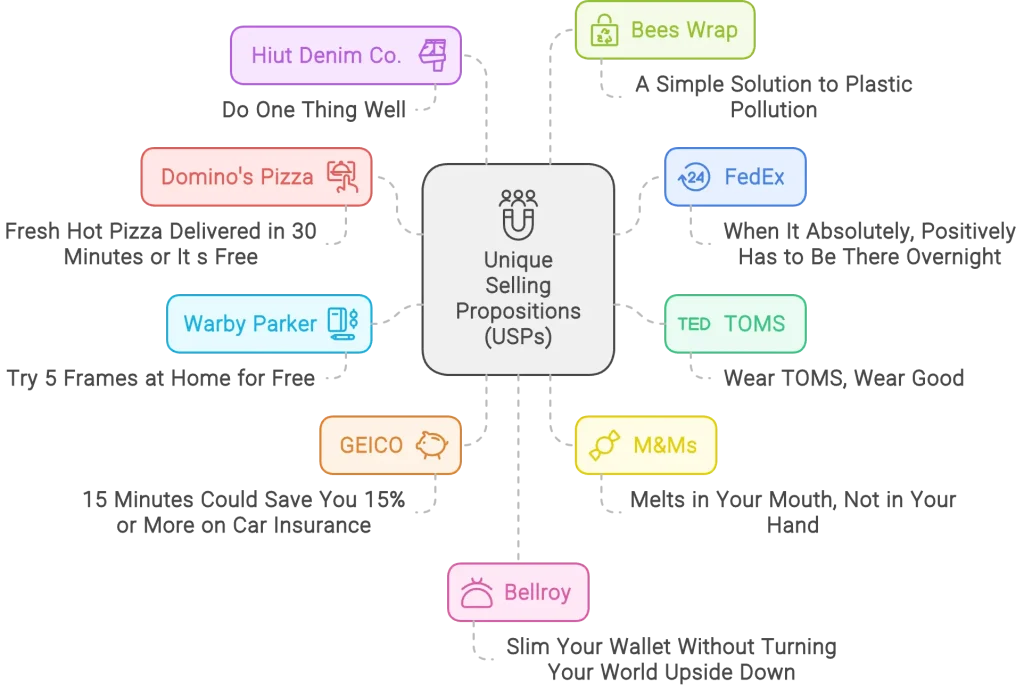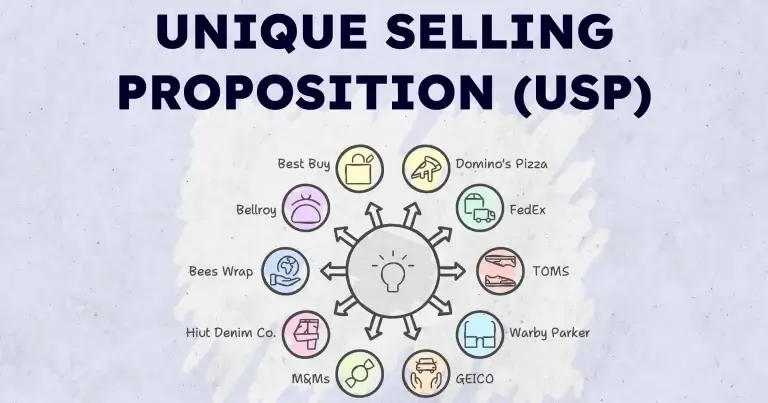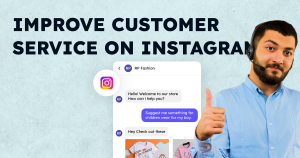A Unique Selling Proposition, or USP, defines what makes your product or service stand out in the market. It highlights unique benefits that attract customers, like Domino’s emphasis on fast delivery.
It clearly communicates the special benefits that set you apart from competitors, helping customers understand why they should choose you.
By identifying and highlighting these unique features, you can strengthen your brand and attract more loyal customers.
A strong USP aligns with a customer-centric approach, ensuring that it resonates with customer needs and preferences, ultimately enhancing satisfaction and loyalty as seen in successful companies like Amazon’s customer focus.

What is a Unique Selling Proposition (USP)?
A Unique Selling Proposition, or USP, is what makes your product or service stand out in a crowded market.
With the rise of AI in customer service, businesses can now utilize impactful AI statistics to improve their USPs by providing faster complaint resolution and personalized support.
It’s crucial to define your USP clearly, as it helps customers understand why they should choose you over competitors.
Defining USP and Its Importance in Business
Understanding the concept of a Unique Selling Proposition (USP) is crucial for any business aiming to stand out in a crowded marketplace. A strong USP helps you differentiate your brand by clearly communicating your value proposition.
It addresses customer needs, improves your marketing strategy, and builds brand loyalty. By investing in excellent customer service, businesses can further solidify their USP, as excellent customer service increases brand awareness and fosters trust among customers.
Crafting a compelling USP can greatly impact your business’s success and customer engagement.
5 Key Statistics on Unique Selling Propositions
1. Businesses with a clearly defined USP are 2.5 times more likely to report significant revenue growth compared to those without one. (Source: Gartner)
2. Companies that effectively communicate their USP see a 20% increase in customer acquisition and a 33% increase in customer retention. (Source: HubSpot)
3. 86% of consumers say authenticity is important when deciding what brands they like and support. (Source: Stackla)
4. Brands with a strong, consistent USP have a 23% higher revenue growth rate compared to those without. (Source: Deloitte)
5. Businesses that focus on their USP see a 68% increase in customer satisfaction and a 55% increase in customer loyalty. (Source: Salesforce)
How a Strong USP Differentiates Your Brand
Crafting a strong Unique Selling Proposition (USP) is key to differentiating your brand in a competitive landscape.
To stand out from the competition, focus on these elements:
- Address customer pain points directly. Understanding customer satisfaction metrics can help identify these pain points effectively, leading to a more tailored approach in your USP.
- Highlight your brand or product’s unique selling point. This should utilize insights from customer feedback, such as customer satisfaction (CSAT), to guarantee that your unique offerings resonate with your target audience.
- Establish a competitive advantage as a clear differentiator.
A successful USP can improve brand recognition and foster customer loyalty.

Key Characteristics of a Unique Selling Proposition
When you think about a Unique Selling Proposition, focus on its key characteristics. A clear and specific statement helps customers understand what makes your product stand out.
By being customer-centric and emphasizing differentiation from competitors, you can create a value-driven message that resonates with your audience.
Furthermore, understanding customer preferences and needs is essential for crafting a compelling proposition that captures attention and fosters trust, as effective customer service leads to increased customer loyalty and retention.
customer service performance metrics can guide you in refining your unique offering to meet market demands.

1. Clear and Specific
A clear and specific Unique Selling Proposition (USP) cuts through the noise of competition and grabs your audience’s attention.
An effective USP should be 10 words or less, making it memorable and easy to recall.
Focus on customer needs, highlighting different selling points that resonate with your target audience.
To create a strong USP, clearly communicate your USP by addressing what makes your product unique.
Leveraging insights from customer interactions can improve your USP by guaranteeing it aligns with customer expectations and needs, leading to enhanced customer service workflows.
Use unique selling proposition examples to illustrate how others differentiate from competitors.
Whether it’s price, quality, convenience, or differentiation, make sure your USP emphasizes the benefits that matter to your customers.
2. Customer-Centric
Building on the importance of a clear and specific Unique Selling Proposition (USP), it’s vital to guarantee that your USP is customer-centric. A customer-centric USP focuses on your ideal customers’ specific needs and pain points, making it easier for them to connect with your brand.
This approach not only increases customer satisfaction and loyalty but also improves the complete customer experience. Effective selling happens when you highlight your unique value in a way that resonates with prospective customers.
This effective customer service techniques approach helps you stand out, as it emphasizes aspects competitors often overlook. Furthermore, researching customer expectations and satisfaction data allows you to refine your USP further.
3. Differentiation from Competitors
Differentiating your brand from competitors is crucial in a crowded marketplace. Your unique selling proposition (USP) clearly defines what sets you apart.
Focus on specific customer needs that your competitors overlook, such as providing exceptional customer service management that fosters loyalty and retention. This differentiation from competitors not only provides a competitive advantage but also helps you attract new customers.
A compelling USP should be concise, ideally 10 words or less, making it easy to communicate. When you effectively communicate your USP, you create a stronger brand identity and reduce consumer confusion.
Meeting customer needs consistently leads to higher retention rates and loyalty. Remember, a well-crafted USP isn’t just a statement; it’s a powerful tool that boosts your brand’s visibility and connection with your target audience.
4. Value-Driven
When crafting a Unique Selling Proposition (USP), focusing on value-driven elements confirms it resonates deeply with your target audience. A customer-oriented USP highlights the specific benefits that matter most to your audience.
Conducting thorough market research helps you identify what your competitors lack and what your target audience truly needs. By emphasizing these unique qualities, you can create a compelling USP that stands out.
This approach not only differentiates your brand but also fosters brand loyalty, as customers feel understood and valued. Moreover, considering how your USP aligns with effective customer service techniques can improve your value proposition.
How to Create a Unique Selling Proposition
Creating a Unique Selling Proposition starts with understanding your market.
You’ll want to conduct thorough research, identify your target audience’s needs, and analyze your competitors’ strengths.
Consider how effective customer service channels can improve your product’s appeal.

Step 1: Conduct Market Research
How well do you know your customers? Conducting market research is crucial for identifying their needs and preferences.
Start by gathering data that helps you understand customer pain points and desires. Here are three steps to guide you:
- Use surveys and focus groups to collect qualitative insights about customer preferences.
- Analyze competitors’ strengths and weaknesses to spot market gaps you can fill.
- Utilize online tools to gauge customer opinions and trends in your industry.
Step 2: Understand Your Target Audience
After gathering insights through market research, the next step is to understand your target audience intimately. To create a compelling Unique Selling Proposition (USP), focus on these key areas:
- Identify their needs: Uncover what your target audience truly wants and needs. This helps guarantee your USP resonates with them.
Understanding how to improve general customer satisfaction can be essential in shaping your approach, as it fosters loyalty and long-term relationships with customers. customer service skills play a significant role in achieving this.
- Develop buyer personas: Create detailed profiles of your company’s ideal customers. This makes it easier to tailor your marketing efforts.
- Foster emotional connections: Align your USP with the values and motivations of your audience. Strong emotional ties can boost customer engagement and loyalty.
Step 3: Analyze Competitors’ USPs
To truly stand out in the marketplace, you’ll want to dig into your competitors’ Unique Selling Propositions (USPs).
Analyzing competitors’ USPs reveals valuable insights that can guide your strategy. Here are three key steps to take into account:
- Identify Gaps in the Market: Look for areas competitors overlook, presenting opportunities for differentiation.
- Evaluate Messaging Strategies: Document how competitors position themselves and their key components, allowing you to refine your approach.
- Monitor Market Trends: Regularly revisit competitor USPs to verify your messaging remains relevant and competitive.
Step 4: Identify Your Unique Strengths
Identifying your unique strengths is crucial for crafting a compelling Unique Selling Proposition (USP). To do this effectively, consider these steps:
- Conduct a SWOT analysis: Identify your strengths, weaknesses, opportunities, and threats to clarify what sets you apart.
- Gather customer feedback: Use surveys and focus groups to learn what customers value most about your product or service.
- Research competitors: Analyze their offerings to pinpoint market gaps where your unique strengths shine, such as superior quality or exceptional customer service.
Step 5: Craft a Clear and Compelling Message
Crafting a clear and compelling message for your Unique Selling Proposition (USP) is vital for capturing your audience’s attention.
Start by summarizing your unique selling proposition in 10 words or less, making it memorable. Make sure this message aligns with your target audience’s values and needs, which helps it resonate better.
Focus on how your offering differentiates from competitors, highlighting aspects they might overlook. Incorporating emotional storytelling can strengthen your connection with customers, fostering brand loyalty.
Furthermore, be open to customer feedback; it’s important for refining your message. By regularly adjusting your USP based on market trends and insights, you’ll maintain its relevance and effectiveness, guaranteeing it continues to draw in your audience.
Step 6: Test and Refine Your USP
Testing and refining your Unique Selling Proposition (USP) is vital for ensuring it resonates with your audience. Start by conducting A/B testing to compare different messaging variations. This helps you determine which version communicates your USP most effectively.
Use tools like OptiMonk to test different headlines and analyze customer responses. After launching your USP, gather feedback from customers and stakeholders to evaluate its clarity and impact. Make necessary adjustments based on their insights.
It’s also important to consistently communicate your USP across all marketing channels to reinforce brand identity.
12 Real-World Examples of Unique Selling Propositions
Now, let’s look at some real-world examples of Unique Selling Propositions.
These brands use their USPs to clearly communicate what makes them special and why customers should choose them.

1. Domino’s Pizza: Fresh Hot Pizza Delivered in 30 Minutes or It’s Free
With regard to pizza delivery, few brands have mastered the art of urgency quite like Domino’s Pizza. Their unique selling proposition, “Fresh hot pizza delivered in 30 minutes or it’s free,” effectively established customer trust and became a key part of their brand identity.
This delivery guarantee was a smart marketing strategy that made them stand out in the fast food industry. Here’s how it worked:
- Speed: Customers crave quick food delivery, and Domino’s promised just that.
- Reliability: The guarantee built a sense of dependability, encouraging repeat orders.
- Competitive Edge: This unique approach pushed competitors to improve their delivery services.
Though modified today, the core promise still resonates, showcasing the power of a well-crafted USP.
2. FedEx: When It Absolutely, Positively Has to Be There Overnight
Few companies have mastered the art of urgency in shipping like FedEx, whose unique selling proposition of “When It Absolutely, Positively Has to Be There Overnight” sets a high standard for reliability and speed.
This commitment has built a strong brand identity and customer loyalty.
Here’s how FedEx achieves this:
- Extensive Logistics Network: With over 650 aircraft and 180,000 vehicles, FedEx guarantees timely deliveries worldwide.
- Consistent Overnight Delivery: This promise meets the urgent needs of businesses and individuals alike.
- Proven Reliability: FedEx’s focus on speed and dependability has solidified its position in the express shipping industry.
3. TOMS: Wear TOMS, Wear Good
FedEx’s commitment to swift and reliable delivery sets a benchmark in express shipping, but TOMS takes a different approach by intertwining fashion with social responsibility. Their unique selling proposition, “Wear TOMS, Wear Good,” captures the essence of their mission to appeal to socially-conscious consumers.
Here are three key elements of their brand messaging:
- One for One Model: For every pair sold, TOMS donates a pair of shoes to a child in need, fostering an emotional connection with customers.
- Transparency: TOMS openly shares its social impact, enhancing trust and loyalty among its audience.
- Expanded Offerings: They now include eyewear and coffee, maintaining their commitment to giving back while reaching a wider market.
4. Warby Parker: Try 5 Frames at Home for Free
In regards to buying eyewear online, Warby Parker stands out by offering a unique selling proposition that allows you to try five frames at home for free.
This home try-on program enhances customer confidence and makes the shopping experience more enjoyable. Here’s how it works:
- Select 5 frames: You can choose five styles to try at home.
- Try them on: Experiment with different looks in your own space.
- Order your favorite: Once you decide, you can easily purchase the frame you like.
This creative approach not only addresses common issues in the competitive eyewear market but also results in a high conversion rate, fostering customer loyalty through a personalized shopping experience.
5. GEICO: 15 Minutes Could Save You 15% or More on Car Insurance
GEICO’s compelling Unique Selling Proposition (USP) captures attention with its promise: “15 minutes could save you 15% or more on car insurance.” This straightforward message appeals directly to consumers seeking both time efficiency and cost savings, making it memorable and easy to understand.
Here’s how GEICO’s USP stands out:
- Direct savings: It highlights substantial savings, attracting price-sensitive consumers.
- Quick process: The emphasis on a short time commitment appeals to busy individuals.
- Strong brand recall: The simple message improves brand recognition across different marketing channels.
6. M&Ms: Melts in Your Mouth, Not in Your Hand
M&Ms stands out in the crowded chocolate market with its unique selling proposition: “Melts in Your Mouth, Not in Your Hand.” This catchy phrase not only emphasizes the candy’s quality and convenience but also addresses a common concern among consumers—no mess while enjoying their treat.
Here’s how M&Ms differentiates itself:
- Quality: The chocolate is designed to be smooth and enjoyable.
- Convenience: You can eat M&Ms without worrying about sticky fingers.
- Consumer Focus: The brand prioritizes a clean and enjoyable consumer experience.
7. Hiut Denim Co.: Do One Thing Well
Hiut Denim Co. exemplifies the power of a focused Unique Selling Proposition with its commitment to “Do One Thing Well.” By specializing exclusively in high-quality denim production, the brand not only hones its craftsmanship but also reinforces its identity in a competitive market.
Here’s how they stand out:
- Craftsmanship: Each pair of jeans is made with care, showcasing their dedication to quality.
- Sustainable Practices: They use high-quality materials that last longer, promoting eco-friendliness.
- Transparency: Customers can track the progression of their jeans, fostering trust.
This community-focused approach encourages you to share your denim stories, enhancing brand identity and customer loyalty.
Hiut Denim Co. shows that a clear USP can connect with consumers seeking authenticity and value.
8. Bees Wrap: A Simple Solution to Plastic Pollution
In the current marketplace, where environmental consciousness is on the rise, Bees Wrap stands out with its inventive approach to reducing plastic waste.
Their unique selling proposition highlights several key features:
- Eco-friendly materials: Made from organic cotton, beeswax, jojoba oil, and tree resin, these wraps are biodegradable.
- Reusable and washable: Each wrap can be used for up to a year, promoting sustainability and helping to reduce single-use plastics.
- Commitment to environmental responsibility: Bees Wrap sources materials from sustainable suppliers, supporting the zero-waste movement.
9. Bellroy: Slim Your Wallet Without Turning Your World Upside Down
Often, consumers find themselves overwhelmed by bulky wallets that disrupt their minimalist lifestyle. Bellroy’s unique selling proposition focuses on slim wallets designed for functionality and style.
Their approach combines quality and craftsmanship with a commitment to being environmentally friendly.
Here’s what makes Bellroy stand out:
- Smart Organization: Features like quick access slots help you find what you need easily.
- RFID Protection: Safeguards your cards from unauthorized scanning.
- Sustainable Materials: They use environmentally certified leather and recycled materials.
Bellroy’s design philosophy emphasizes elegance in everyday carry solutions.
With a growing customer base and positive reviews, it shows how slim wallets can improve your minimalist lifestyle without sacrificing practicality.
10. Best Buy: Find a Lower Price and We’ll Match It
When you’re shopping for electronics, knowing you won’t pay more than necessary can make all the difference.
Best Buy’s unique selling proposition is its price matching policy, which focuses on competitive pricing to build customer trust.
Here are three key aspects of this approach:
- If you find a lower price on an identical item, Best Buy matches it.
- This policy covers a wide range of products, including electronics and appliances.
- Best Buy promotes this offer actively in its marketing campaigns.
11. American Musical Supply: Rock Now! Pay Later
American Musical Supply (AMS) stands out in the competitive musical supply market with its “Rock Now! Pay Later” unique selling proposition. This program offers flexible payment options, allowing musicians immediate access to instruments and gear without the financial burden.
Here’s how it works:
- Defer Payments: You can purchase equipment and pay later, easing financial challenges.
- Support for All Musicians: It caters to students and hobbyists with limited budgets, promoting accessibility and convenience.
- Builds Customer Loyalty: By addressing your needs, AMS positions itself as a customer-centric brand, enhancing satisfaction.
This approach not only differentiates AMS from competitors but also reinforces its commitment to the musical community, making it a great choice for aspiring musicians seeking affordability.
12. Thrive Market: Healthy Groceries Shouldn’t Break the Bank
Thrive Market transforms the grocery shopping experience by making healthy eating affordable for everyone. Their unique selling proposition focuses on affordable access to high-quality organic groceries through a membership model. This allows members to save 25-50% on their grocery bills.
Here are three key features that set Thrive Market apart:
- Wide Selection: They offer over 6,000 products, catering to diverse dietary preferences, including organic, gluten-free, and vegan items.
- Sustainability Commitment: Thrive Market partners with brands that prioritize environmental stewardship, appealing to socially conscious shoppers.
- Philanthropic Efforts: For every membership sold, they donate one to a low-income family, enhancing community support.
How to Implement Your Unique Selling Proposition in Marketing
To effectively implement your Unique Selling Proposition in marketing, start by using it in your advertising campaigns.
Make sure it appears across all touchpoints, like social media posts, emails, and product descriptions, to create a unified message.
Using USP in Advertising Campaigns
A strong advertising campaign hinges on a well-defined Unique Selling Proposition (USP) that sets your brand apart.
To effectively use your USP, follow these steps:
- Integrate your USP into all advertising materials, ensuring consistent marketing messages that reinforce your brand’s identity.
- Utilize compelling visuals and taglines that highlight your USP in ads to capture attention and improve memorability.
- Leverage social media platforms to promote your USP with targeted ads, aligning with customer interests to increase visibility and conversion.
Applying Your USP Across All Touchpoints
Integrating your Unique Selling Proposition (USP) across all marketing touchpoints is crucial for creating a cohesive brand experience.
To effectively apply your USP, consider these steps:
- Update marketing materials: Verify all your advertisements, social media posts, and promotional content prominently feature the unique selling proposition, reinforcing brand identity.
- Create targeted landing pages: Design landing pages for specific campaigns that clearly communicate your USP, highlighting benefits and encouraging action from your audience.
- Train your team: Equip sales and customer service teams to communicate your USP during interactions, making the sales process smoother and more effective.
Also, regularly monitor customer feedback to gauge your USP’s impact, allowing you to make necessary adjustments and improve the complete experience.
Leveraging Your USP in Product Descriptions
Utilizing the power of your Unique Selling Proposition (USP) in product descriptions can greatly improve your marketing efforts.
To effectively communicate your USP, consider these key aspects:
- Highlight Unique Benefits: Clearly explain what sets your product apart from competitors, focusing on its unique features and benefits.
- Use Engaging Language: Craft descriptions that evoke emotions, creating a connection between the product and the consumer to increase perceived value.
- Include Customer Testimonials: Utilize social proof by incorporating testimonials that reinforce your USP, demonstrating the product’s effectiveness and reliability.
Common Mistakes to Avoid When Crafting a USP
When crafting your Unique Selling Proposition, it’s essential to avoid common pitfalls that can weaken your message.
Being too vague or generic can lead to confusion, while focusing solely on price might make you forget what truly sets you apart.
Always remember to take into account your customer’s perspective to create a compelling and effective USP.
Being Too Vague or Generic
A vague or generic Unique Selling Proposition (USP) can leave your brand lost in a sea of competitors, making it hard for customers to remember what sets you apart. Instead of saying “we provide great customer service,” specify what you offer, like “24/7 customer support.”
This clarity helps highlight specific benefits that resonate with your target market. A generic USP fails to define your brand identity, resulting in missed opportunities to connect with potential customers.
To create an effective USP, focus on unique features that differentiate your business. Avoid broad statements and aim for clear, concrete examples that showcase what makes your product or service stand out.
Focusing Solely on Price
Relying exclusively on price as your Unique Selling Proposition (USP) can be a slippery slope. Price-based USPs often attract customers who care only about low costs, but this approach rarely builds long-term loyalty.
These customers might easily switch to competitors offering better deals. By focusing solely on price, you risk overlooking unique features that could help differentiate yourself in a crowded market. This narrow focus can diminish perceived value, making it hard to justify higher prices for premium products later on.
Furthermore, concentrating on price can hinder innovation and improvement, as you divert resources to maintain low costs instead of enhancing customer experience. Aim to balance pricing with quality and unique benefits to foster a stronger brand reputation.
Ignoring the Customer’s Perspective
Ignoring the customer’s perspective can severely undermine your Unique Selling Proposition (USP). To create an effective USP, you must prioritize understanding customer needs and preferences.
Remember, 70% of customer decisions depend on how well their needs are met. Engage with your target audience through customer feedback, which provides valuable insights into their expectations and experiences.
If you focus only on product features without highlighting benefits, you may alienate potential buyers, since 80% prefer brands that communicate relevant value.
Moreover, ineffective marketing strategies can result from neglecting customer viewpoints.
Ultimately, integrating consumer preferences into your brand communication helps guarantee your USP resonates with the audience, improving engagement and loyalty over time.
Conclusion
A strong Unique Selling Proposition can have a lasting impact on your brand.
It not only sets you apart from competitors but also builds customer loyalty and trust.
Frequently Asked Questions
How a USP Can Drive Brand Loyalty and Growth?
When you think about your favorite brands, their unique selling propositions (USPs) likely come to mind, showcasing what sets them apart.
A strong USP drives brand loyalty by clearly communicating benefits that differentiate your brand. This builds customer trust, boosts customer retention, and improves market share.
Ultimately, focusing on your unique selling proposition can lead to lasting growth and stronger connections with your audience.
Final Tips for Refining Your Unique Selling Proposition
Refining your Unique Selling Proposition (USP) is essential for staying relevant in a competitive market.
Regularly assess market trends and customer feedback to refine your USP. Clearly communicate how your brand differentiates itself from competitors, addressing specific needs.
This not only improves your brand identity but also fosters customer loyalty, ensuring your message resonates effectively with your target audience.
How Do You Define a Unique Selling Proposition?
Defining a Unique Selling Proposition (USP) boils down to pinpointing what makes your product or service stand out in a crowded marketplace.
To create a compelling USP, focus on these key aspects:
Customer-oriented: Understand the desires and needs of your target audience.
Market research: Identify gaps in the market and analyze competitors to find what they overlook.
Differentiate: Clearly articulate the unique value your product or service offers.
A strong USP not only improves brand loyalty but also guarantees your messaging resonates.
Keep it concise, ideally in 10 words or less, to clearly communicate your unique selling proposition.
What’s the Difference Between a USP and a Value Proposition?
Clarity in messaging is crucial when distinguishing between a Unique Selling Proposition (USP) and a value proposition. Here are three key differences:
Focus: A USP highlights what makes your product stand out from competitors, while a value proposition outlines the complete value and benefits customers can expect.
Length: A USP is brief, often a catchy phrase of ten words or less, whereas a value proposition is more thorough, detailing how your offering solves customer problems.
Purpose: USPs emphasize differentiators that appeal to target customers, while value propositions aim to align with customer expectations and experiences.
Understanding these differences helps refine your brand messaging, ensuring you effectively communicate both the unique selling proposition and the complete value of your offering.
Can a USP Change Over Time?
A Unique Selling Proposition (USP) can often change over time as businesses adapt to evolving consumer preferences and market dynamics.
Here are three key factors that can influence this change:
Market Trends: New trends can shift what consumers value in a product or service.
Competitive Landscape: As competitors adjust their offerings, you may need to revise your USP to maintain differentiation.
Consumer Preferences: Regularly gathering feedback helps you stay aligned with what your customers truly want.





